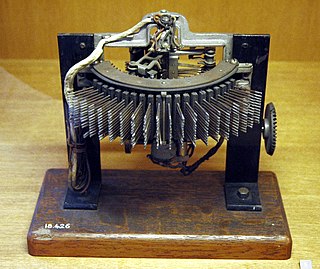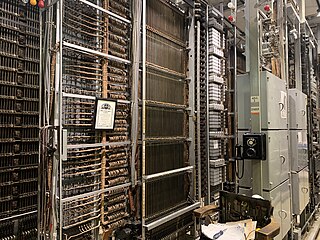
Dual-tone multi-frequency signaling (DTMF) is a telecommunication signaling system using the voice-frequency band over telephone lines between telephone equipment and other communications devices and switching centers. DTMF was first developed in the Bell System in the United States, and became known under the trademark Touch-Tone for use in push-button telephones supplied to telephone customers, starting in 1963. DTMF is standardized as ITU-T Recommendation Q.23. It is also known in the UK as MF4.

A rotary dial is a component of a telephone or a telephone switchboard that implements a signaling technology in telecommunications known as pulse dialing. It is used when initiating a telephone call to transmit the destination telephone number to a telephone exchange.

A telephone switchboard was a device used to connect circuits of telephones to establish telephone calls between users or other switchboards, throughout the 20th century. The switchboard was an essential component of a manual telephone exchange, and was operated by switchboard operators who used electrical cords or switches to establish the connections.

Pulse dialing is a signaling technology in telecommunications in which a direct current local loop circuit is interrupted according to a defined coding system for each signal transmitted, usually a digit. This lends the method the often used name loop disconnect dialing. In the most common variant of pulse dialing, decadic dialing, each of the ten Arabic numerals are encoded in a sequence of up to ten pulses. The most common version decodes the digits 1 through 9, as one to nine pulses, respectively, and the digit 0 as ten pulses. Historically, the most common device to produce such pulse trains is the rotary dial of the telephone, lending the technology another name, rotary dialing.
In telephony, ringdown is a method of signaling an operator in which telephone ringing current is sent over the line to operate a lamp or cause the operation of a self-locking relay known as a drop.
Plain old telephone service (POTS), or plain ordinary telephone system, is a retronym for voice-grade telephone service employing analog signal transmission over copper loops. POTS was the standard service offering from telephone companies from 1876 until 1988 in the United States when the Integrated Services Digital Network (ISDN) Basic Rate Interface (BRI) was introduced, followed by cellular telephone systems, and voice over IP (VoIP). POTS remains the basic form of residential and small business service connection to the telephone network in many parts of the world. The term reflects the technology that has been available since the introduction of the public telephone system in the late 19th century, in a form mostly unchanged despite the introduction of Touch-Tone dialing, electronic telephone exchanges and fiber-optic communication into the public switched telephone network (PSTN).
A dial tone is a telephony signal sent by a telephone exchange or private branch exchange (PBX) to a terminating device, such as a telephone, when an off-hook condition is detected. It indicates that the exchange is working and is ready to initiate a telephone call. The tone stops when the first dialed digit is recognized. If no digits are forthcoming, the partial dial procedure is invoked, often eliciting a special information tone and an intercept message, followed by the off-hook tone, requiring the caller to hang up and redial.

A blue box is an electronic device that produces tones used to generate the in-band signaling tones formerly used within the North American long-distance telephone network to send line status and called number information over voice circuits. This allowed an illicit user, referred to as a "phreaker", to place long-distance calls, without using the network's user facilities, that would be billed to another number or dismissed entirely as an incomplete call. A number of similar "color boxes" were also created to control other aspects of the phone network.

The Strowger switch is the first commercially successful electromechanical stepping switch telephone exchange system. It was developed by the Strowger Automatic Telephone Exchange Company founded in 1891 by Almon Brown Strowger. Because of its operational characteristics, it is also known as a step-by-step (SXS) switch.

A telephone keypad is a keypad installed on a push-button telephone or similar telecommunication device for dialing a telephone number. It was standardized when the dual-tone multi-frequency signaling (DTMF) system was developed in the Bell System in the United States in the 1960s that replaced rotary dialing originally developed in electromechanical switching systems. Because of the installed abundance of rotary dial equipment well into the 1990s, many telephone keypads were also designed to produce loop-disconnect pulses electronically, and some could be optionally switched to produce either DTMF or pulses.

A telephone call or telephone conversation, also known as a phone call or voice call, is a connection over a telephone network between the called party and the calling party. Telephone calls started in the late 19th century. As technology has improved, a majority of telephone calls are made over a cellular network through mobile phones or over the internet with Voice over IP. Telephone calls are typically used for real-time conversation between two or more parties, especially when the parties cannot meet in person.
A vertical service code (VSC) is a sequence of digits and the signals star (*) and pound/hash (#) dialed on a telephone keypad or rotary dial to access certain telephone service features. Some vertical service codes require dialing of a telephone number after the code sequence. On a touch tone telephone, the codes are usually initiated with the star key, resulting in the commonly used name star codes. On rotary dial telephones, the star is replaced by dialing 11.
In telephony, multi-frequency signaling (MF) is a type of signaling that was introduced by the Bell System after World War II. It uses a combination of audible tones for address transport and supervision signaling on trunk lines between central offices. The signaling is sent in-band over the same channel as the bearer channel used for voice traffic.
Automatic Electric Company was an American telephone equipment supplier primarily for independent telephone companies in North America, but also had a worldwide presence. With its line of automatic telephone exchanges, it was also a long-term supplier of switching equipment to the Bell System, starting in 1919. The company was the largest manufacturing unit of the Automatic Electric Group. In 1955, the company was acquired by General Telephone and Electronics (GT&E). After numerous reorganization within GTE, the companies assets it came under the umbrella of Lucent in the 1990s, and subsequently part of Nokia.

The Western Electric model 500 telephone series was the standard domestic desk telephone set issued by the Bell System in North America from 1950 through the 1984 Bell System divestiture. Millions of model 500-series phones were produced and were present in most homes in North America. Many are still in use today because of their durability and ample availability. Its modular construction compared to previous types simplified manufacture and repair, and facilitated a large number of variants with added features.

Tip and ring are the two conductors or sides of a telephone line. Their names are derived from the telephone plugs used for connecting telephone calls in manual switchboards. One side of the line is connected to the metal tip of the plug, and the second is connected to a metal ring behind the tip, separated and insulated from the tip by a non-conducting material. When inserted into a jack, the plug's tip conductor connects first, followed by the ring conductor. In many European countries, tip and ring are referred to as the A and B wires.

The push-button telephone is a telephone that has buttons or keys for dialing a telephone number, in contrast to having a rotary dial as in earlier telephone instruments.

A telephone exchange, telephone switch, or central office is a telecommunications system used in the public switched telephone network (PSTN) or in large enterprises. It interconnects telephone subscriber lines or virtual circuits of digital systems to establish telephone calls between subscribers.
A group switching centre (GSC) was a United Kingdom telephone exchange used to provide local and trunk routing to local exchanges within its own and if required, adjacent group areas.

The Panel Machine Switching System is a type of automatic telephone exchange for urban service that was used in the Bell System in the United States for seven decades. The first semi-mechanical types of this design were installed in 1915 in Newark, New Jersey, and the last were retired in the same city in 1983.












